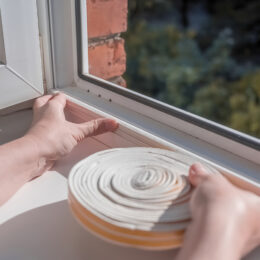By Patrick Keegan and Amy Wheeless

Regularly vacuuming your air filters is something you can do to extend their life and improve your system’s efficiency. Photo: Janwikifoto
I recently moved from a home with wall-mounted heaters to one with central heat and air, and a duct system. How can I ensure my ducts are working efficiently?
Homes with central forced-air heating and cooling systems, like furnaces, central air conditioners and heat pumps, use air ducts to deliver the conditioned (heated or cooled) air through the home. Ducts are often concealed in walls or in areas of your home you don’t go to often, like a crawlspace, so many people do not immediately think of them as an area to save energy.
You may have received flyers in the mail with offers for air-duct cleaning and claims that doing so will improve the air quality and efficiency of your home. However, duct cleaning may not always be necessary for air quality, and there is no indication that just cleaning your air ducts will improve your system’s efficiency.
Duct cleaning may be necessary if:
• There is visible mold in your duct system or there was a recent flood that caused mold or mildew in your home.
• There is something in the ductwork impeding airflow, like debris or an infestation. Major renovations or new construction can put construction debris into the duct system, so post-construction is an ideal time to consider duct cleaning.
• Your heating registers are releasing dust into the air.
• Residents of your home have allergies or asthma problems that have not been alleviated by other changes.
While duct cleaning may not always be necessary, regularly changing your air filters can help your heating and cooling system work more efficiently. How often you change them depends on how much your system runs, whether you have pets and whether you periodically vacuum your air filters. For the average home, air filters should be changed four to six times a year.
Though duct cleaning may not do much for the efficiency of your systems, duct sealing is important for saving energy and lowering utility costs, particularly if your ducts are in unconditioned spaces, like a crawlspace or an uninsulated attic.
In a typical home, 20 to 30 percent of heated or cooled air escapes through unsealed gaps and holes in the duct system, which can cost you money and make your home less comfortable. You wouldn’t put up a with a leaking water pipe, so why should you put up with a leaking air duct?
The best way to assess the condition of your home’s ductwork is to have it tested by a professional home energy auditor who can conduct a Duct Blaster test. If you can easily access your ducts, you might get by with a visual inspection, which will identify the larger holes and disconnections. Where ducts meet or where they connect to a heating register are common places to find leaks. A professional trained in ductwork can help you identify and fix the gaps and leaks you may not be able to see. Talk to your local electric co-op to find the right person for the job.
Once gaps and leaks have been identified, you can work to seal your ducts. Small duct leaks can be sealed with mastic, a type of caulk. Larger duct leaks and disconnections may require additional lengths of duct, mechanical fasteners or special heat-resistant tape. Do not use duct tape — ironically, it is not designed to adhere well to ducts.
If you have ducts in unconditioned areas, like an attic or crawlspace, your ducts could be wasting energy by heating or cooling the surrounding air, even if there are no leaks. Insulation around the ducts can help reduce this energy loss. Consider adding insulation to the unconditioned space which can further increase the efficiency and comfort of your home.
Patrick Keegan writes on consumer and cooperative affairs for the National Rural Electric Cooperative Association, service arm of the nation’s 900-plus consumer-owned, not-for-profit electric cooperatives based in Arlington, Virginia. Amy Wheeless writes for Collaborative Efficiency. For more information, visit:www.collaborativeefficiency.com/energytips or email Pat Keegan at energytips@collaborativeefficiency.com.



